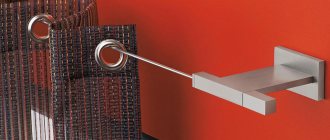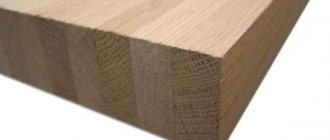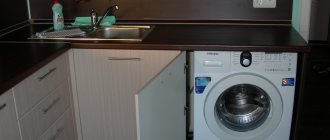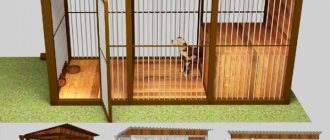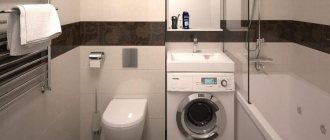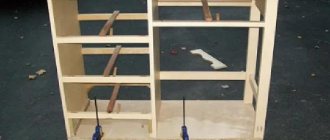Types of drainage devices under the sink
There are many device options.
Pipe
The device is a curved pipe, which in most cases is metal. This older example of the device is called a knee. The modern version of the siphon is lightweight, has a shiny bronze or brass surface and convenient connectors.
The curved area is located at the bottom of the structure where waste accumulates. If there is a need to install 2 drain holes, then the pipe elbow is installed closer to the pipe leading to the sewer. Above the drain, pipes and adapters are assembled, making 2 drains into one up to the pipe elbow.
Tubular siphon design
Corrugated
The corrugated device is a curved tube where the bend is formed due to the corrugation. This area makes the device movable and facilitates connection to the drain. The soft hose is made of plastic, and a clamp is used to maintain the corrugation. It can be moved, straightening the folded area or making it more pronounced.
Corrugated folds have disadvantages, which include the accumulation of dirt and food deposits in them. The part is difficult to clean. The downside is the thinning of the material, which can leak. Due to the properties of plastic, boiling water should not be poured into the sink.
Corrugated siphon design
Bottle
In most cases, a bottle siphon is used for installation. It looks like a bottle, inside which water moves along a curved space formed by a double partition. The liquid moves inside the tube and enters the lower part of the device. Afterwards, the drains are directed up the space between the outer and inner partitions of the device and then, thanks to a side hole, flow into the sewer.
This adapter receives the main drains from above, and on the side there is another drain from the plumbing equipment. The bottle drain can be metal or plastic. Metal structures are durable, and plastic ones are affordable.
Bottle siphon design
Dry siphon
There is no permanent accumulation of water in the design. Inside there are rubber seals that act as a water seal and block the passage of unpleasant odors. When the liquid is drained, the rubber moves, allowing the drains to pass through, and returns to its original position after they pass through. The rubber part is called a dry water seal. Due to the lack of liquid, the device is installed in cold rooms, where freezing of the water seal and deformation of pipes can occur.
In such houses, a dry structure is installed, characterized by its small size and the absence of a curved part. The dry siphon can be installed in cold and hot rooms, in small areas, in objects subject to shaking and vibration, as well as in air conditioner drains.
Dry siphon design
Main varieties
According to their design, all siphons used for kitchen sinks can be divided into several types:
- Bottle. This is a rigid structure that can be unscrewed from the bottom. Thanks to this, the device can be cleaned quickly and easily. The lower removable part retains not only debris, but also jewelry or any hard objects that accidentally fell into the sink. A corrugated or rigid drain pipeline can be connected to the “bottle”. There is always water inside the housing, which ensures a water seal.
- Corrugated. Essentially, it is a flexible pipe, bent in a certain place and secured with a clamp. The bend is intended to create a water seal. The remaining part of the siphon can be freely bent in the desired direction. The corrugated siphon for washing has a significant drawback, expressed in the roughness of its inner surface, on which debris is retained. Because of this, the structure often has to be removed and cleaned.
- Pipe. This is a rigid, “S”-shaped pipe that takes up fairly little space.
- Flat. This is an ordinary siphon, all elements of which are located in a horizontal plane. Used in cases where there is a shortage of free space under the sink.
- Hidden. This can be a device of any design, which is hidden in a wall or in some kind of box.
- With overflow. An additional element in the design is a rigid overflow pipe that connects the top of the sink with the drain hose.
- Siphon for washing with a jet break. It differs from a conventional siphon by the presence of a small gap (2-3 cm) between the outlet and inlet water holes. Thus, the path of penetration of microbes from the sewer pipe into the sink is stopped. Such products can often be found in catering establishments.
Siphon for washing and its functions: type, diameter, size
To ensure that the sink is always clean and does not emit a bad smell, you need to install a water seal
The high location of the sink in the kitchen allows you to take advantage of a considerable choice in the support of such a device, which means you can purchase a model with large dimensions for the water seal. For a shower tray or bathtub, the choice of a similar device is more limited; here you will need to take into account its dimensions.
- The pipe type siphon is presented in the form of a rigid pipe resembling a U or S-shape. The device can be used in a collapsible or non-dismountable version. For convenient cleaning, models are most often produced with a built-in plug at the bottom, which is easily removed. The disadvantage of this option is the forced precise calculation between the entrance to the sewer and the hole from the sink.
- The bottle-shaped device has a water seal in the form of a bottle (glass) in its lower part. The connection to the sewer system is made using both straight and flexible pipes. This type of siphon is easier to disassemble and takes up less space. The disadvantage can be considered the tendency to quickly become dirty, but the design itself has become the most popular in use due to its ease of maintenance.
- The corrugated type of siphons can be considered a universal design, which is a flexible tube. The corrugated siphon is easy to install, and the slope for the water seal can be easily created by manually forming the bend of the tube. The disadvantages include the non-removable type of construction and rapid contamination that occurs due to the corrugated surface.
By acquiring the desired shape of the device, connection to the sewer system can be made in the most non-standard locations of the washbasin. You can read about the Kaiser kitchen faucet in this article.
In addition to its direct duties, a siphon can prevent the loss of a favorite item, such as jewelry, that accidentally ends up in a drain. All objects, due to their weight, settle in the water seal and to remove them, you just need to open it.
The direct responsibility of any siphon is to prevent sewer gases from entering the room where a person will be forced to inhale them, and each model of the device copes with this task in its own way. But each device can have additional functions. A diagram of connecting a water floor to a heating system can be viewed here.
For example:
- Hidden siphons are installed in a special box, which is located in the wall or attached to it, this allows you to better decorate the area. A problem may arise when a breakdown occurs, when you first need to find it and then fix it;
- For modern kitchens, models that have a double or triple outlet at the top of the connection are well suited. This could be, for example, a sink with several sinks or a sink and washing machine;
- Recently, siphons and sinks that have a drain-overflow function have become very common. A pipe that prevents water from overflowing into the sink and thereby flooding the kitchen is connected from the sink to a special hole in the siphon.
This type allows you to connect several drains to the sewer hole at once.
Components
Different types of siphons have different designs, so we will consider in detail the design of a bottle-type siphon, the most popular for installation under kitchen sinks.
Structurally, such a device consists of the following elements:
- body, usually dismountable;
- outlet pipe with raised rings, connected to the sink from below;
- protective mesh with a cell diameter of no more than 1 cm;
- connecting screw connecting the mesh and the pipe;
- corrugated or rigid tube for draining water into the sewer;
- cone gaskets designed to ensure tight contact between the pipes and the siphon body;
- wide rubber gasket for attaching the outlet pipe to the sink;
- rubber gasket designed to seal the protective grille;
- plastic union nuts. They attach the pipes to the device body.
Components of a bottle siphon
How to choose the right siphon
If you decide to manually select and install a siphon, pay attention to the following recommendations:
- buy a siphon along with the sink or after you purchase the sink. This will make it easier to select sizes or even install elements from a single set;
- Siphons are sold together with pipes of different diameters. The smaller it is, the more often you will have to clean the pipe from blockages, since a small connector will not allow all contaminants to quickly pass into the sewer;
- When choosing a siphon for your kitchen sink, be sure to check the drainage elements. It is likely that you will come across defective products, especially those that have threads. If you use parts with chips and burrs, the joint will not be of high quality, and the gaskets will be damaged;
- If you have dishwashing and washing equipment next to the sink, you should definitely provide for water drainage into the sewer, so take care of an additional outlet for connecting the pipe through which the drain will be carried out. At the purchasing stage, decide how the siphon is attached to the kitchen sink. Calculate how much space you can allocate for these purposes, and choose models that suit your parameters.
Practical recommendations
Installation of a hinged P-siphon.
The process of installing a siphon on a sink can be divided into stages:
- First, you need to attach the bottom plug to its proper place, exactly where there will be a constant level of pressure in the structure. When purchasing a siphon, many professionals recommend unscrewing this same plug to make sure its quality and absence of chips.
- At the second stage, you should check the lower surface of the product, which will precisely be connected to the body. The surface of this thread must be free of burrs. It is for this reason that equipment for home installation should be carefully checked and reviewed directly at the store where it is purchased.
- A thin rubber lining in the shape of a ring is installed in a specialized groove in the structure, after which the surface is carefully treated using a mixture of silicone sealant. When working with this mass, it is imperative to cover the lower area with the composition.
Installing siphons for draining liquid from a sink requires a fairly rigid installation.
But on the modern market you can come across pipes and hoses that have a flexible corrugated design; such products stretch to the required size, but at the same time have the necessary density indicators and the ability to hold their shape. For installation work, you can use pipes of 3.2, 4 and 5 cm in diameter, or even buy universal ones, which are suitable for connecting almost any design. Installation of such a product is carried out directly to the thread using a union-type nut. It is the nut that makes it possible to connect the pipe to the siphon thread using a flat cover.
The normal functioning of both the kitchen sink and the bathroom bowl and washbasin is impossible without a siphon, and its correct installation will ensure the comfort of using this kind of plumbing parts. In the modern building materials market you can find a variety of designs that are suitable for solving various problems. But for sinks and kitchen sinks, bottle-type products with a drain hole with a diameter of 3.2 cm are still preferable. Installation of such a product is easy to do with your own hands in a short amount of time.
How to connect a siphon to a sink
- Types of siphons
- Bottle and knee designs
- Subtleties of the process
- Sink connection
- Practical recommendations
Installation of plumbing equipment both in the kitchen and in the bathroom involves connecting not only to the water supply, but also to the sewer system pipe. Most owners of apartments and houses mistakenly assume that the task associated with connection must certainly be performed by professionals. In fact, installing a siphon is not that complicated and installation does not require any specialized tools or a lot of time. After reading the following, everyone can find the answer to the question of how to connect a siphon to a sink.
Siphon assembly and installation
Upon completion of preparation, you can proceed directly to the installation of the siphon. Assembly can be started in different ways. The first method involves pre-assembling the base of the structure and securing it to the sink. But you can also go the opposite way and gradually assemble all the elements directly at the sink. This does not change the essence, but in some cases both options may be uncomfortable for the plumber, or for you, depending on who is involved in the work.
Regardless of the type of water seal, installation is carried out according to the same principle
Many people recommend pre-assembling the main part and then installing it directly on the sink, citing the fact that there is not much space under it for maneuvering hands and tools, and there is usually no light at all. Therefore, we will assemble the siphon and fittings in parts.
Installation of the structure on the sink
Sink connection
To arrange the connection of a kitchen sink and its subsequent comfortable operation, it is recommended to use products with a drain hole of 3.2 cm in diameter. It is these parameters of the hole that are considered the most convenient and at the same time compact; in addition, this parameter ensures ease of installation of the siphon for various sinks, as well as ease of subsequent operation.
Before you begin installing the product, you should first become familiar with its structure. Any siphon for connecting sinks in the kitchen is a product consisting of such components as:
- plastic flow pipe, equipped with a metal insert;
- pipe gasket made of latex;
- nuts with a diameter of 3.2 cm made of plastic;
- cuff-skirt made of elastic and soft plastic, with a hole in it 3.2 cm in diameter;
- a tightening screw made of steel;
- cover for the drain part, also made of steel;
- the body of the product, called the bottle;
- bottom plug;
- ring-shaped rubber gasket;
- plug for locking the drain, overhead.
In the process of installing siphons of this kind on a sink or washbasin, maximum attention should be paid to such a parameter as the tightness of each connection of the structure
Bottle and knee designs
To connect a washbasin in a room for water procedures, that is, in a bathroom, professionals advise using a bottle-type siphon. To understand why this type is preferable will be made possible by considering the composition and features of this type of equipment.
Assembly diagram for a sink with a siphon.
Connecting a siphon of this type is a simple operation and can easily be done by the owners themselves. The installation procedure involves connecting the device at one end to the drain of a sink or bathtub, and the other to the outlet of the sewer pipe.
The design of the product itself is extremely simple, and caring for it is not particularly difficult. The main thing during the installation process is to ensure that all sealing rubber gaskets are installed and not a single one is lost or forgotten. This point is very important, not so much for the installation process, but for the convenience and comfort of operation in the future, because such rubber products will ensure no leakage of wastewater.
For kitchen sinks, the best choice is a knee siphon made of metal or plastic. The installation of this type of structure in general practically repeats the connection of a bottle siphon. The differences are that instead of an element, which is called a bottle, it is necessary to install a curved element of a rigid type, called an elbow.
The uniqueness of this design lies in the fact that it can only be installed if the sewer pipe is located in the wall.
Design
The drainage system for sinks and sinks is the simplest system, consisting of a siphon and a drain pipe that connects the sewer and the drain hole located at the bottom or wall of the bowl. This plumbing product is usually made of plastic, metal, or a combination of these materials. The sink drain consists of the following structural elements:
- Body or "glass".
- Outlet pipe.
- Cuffs and seals made of plastic or rubber.
- Protective and decorative metal grille for the drain hole.
- Plastic nuts.
- Fixing screw.
Bottle siphon design
Note! There are also drains for sinks with overflow, which differ from the usual ones by having an additional drain hole located above the main one. This hole is connected by an additional corrugation to the siphon body
An overflow prevents the sink from overflowing and water from spilling out of the bowl if you forget to turn off the faucet or the drain hole is clogged.
Types of siphons: designs and materials
All sink drainage devices are made of plastic or metal. Plastic are divided into:
- Polyethylene. They have a simple design and a small number of connections.
- Polypropylene. More common because the sink siphon parts are stiffer and the connections are more reliable. This allows you to maintain the shape of the product.
- Polymers. This material is less susceptible to thermal expansion, so it must be chosen if you plan to install a washing machine in the kitchen.
Metal products are more expensive than plastic ones. The materials most often used are brass and bronze. They do not corrode, but do oxidize, so they are subject to:
- chrome plating;
- galvanizing.
The most expensive are stainless steel sink siphons. Due to their high cost, they have not gained popularity.
Plastic sink siphons are more popular because they are easy to adjust to the inlet and outlet openings.
When choosing a metal product, you need to know exactly the location of the drain and sewer connectors.
Depending on the type of design, hydraulic dampers are:
- pipe;
- bottled;
- corrugated;
- hidden;
- with overflow.
With overflow
The siphon with overflow for the sink has an additional pipe. It connects to the overflow hole in the sink. Thanks to drainage, flooding of the room can be prevented. This type of hydraulic barrier is the most popular. Almost all siphons are equipped with an additional tube. It is necessary to purchase such a product only if there is an overflow hole in the sink.
Pipe
The drainage system in appearance resembles a curved pipe. Water collects in the bend, which creates a plug and prevents unpleasant odors from penetrating into the room. This is the most compact type of device. Installation of a metal siphon is most often carried out in bathrooms. This is due to the fact that as much garbage and food waste does not end up in the bathroom sink as in the kitchen. And dismantling the knee is more difficult than in other types of devices.
Also, pipe hydraulic valves have a shallow bend for a water plug. If the sink is not used for a long time, the water in the sink evaporates and sewer odors spread throughout the room. If clogged, do not remove the entire device, but only the lower elbow.
Corrugated
This is the simplest and cheapest type of siphon, which consists of a corrugated tube and connecting elements. The product is flexible, so it can be easily mounted to the sewer in any place and at different angles. To create a water plug, you need to manually bend the hose into a U or S shape and secure it. This is especially convenient in cases where the distance between the floor and the sink is small.
The disadvantages are:
- No intermediate connections. In the event of a leak, it is necessary to replace the entire kit, and not its individual elements.
- Difficult to clean. Since the pipe is not removable, to remove the blockage it is necessary to completely flush the siphon.
- Deposits quickly form on the inner walls.
Bottle
This model is the most common. It got its name due to its design, which resembles a flask or bottle. The following advantages of a bottle water seal for sinks are highlighted:
- the compartment in which debris accumulates and most often becomes clogged can be easily unscrewed and removed;
- has a long service life;
- the water never leaves completely, therefore it reliably provides protection against sewer odors;
- there is an overflow, which prevents flooding of the room;
- Small valuables left in the sink remain in the water tank, so they can be easily removed by unscrewing the flask.
Siphon for kitchen sinks: types, design and installation
The article is posted in the category|subcategory
The kitchen sink is the most important and essential element of kitchen plumbing equipment. It consists of several parts, which, when connected together, provide the functionality of the sink. One of the components through which water is drained is the kitchen sink siphon. Regardless of its appearance and size, this plumbing element is designed to fulfill its main function - to protect the kitchen from unpleasant odors emanating from sewer pipes. In other words, what we have in front of us is a typical water seal, in which a curved tube is constantly filled with water. In addition, the kitchen sink drain prevents the drain from clogging with solid particles that settle at the bottom of the siphon.
Features of a siphon for kitchen sinks
The materials used to make kitchen drainers are polyethylene and polypropylene. The vast majority of products are made from them. These materials have the following advantages over bronze or brass siphons:
- less weight, so the sink made of thin-walled metal is not loaded;
- fat and other types of deposits accumulate on plastic less;
- corrosion and rotting from excess moisture are completely absent;
- long service life of plastic siphons;
- the cost of such a device is quite affordable.
The siphon has a drain pipe to which a corrugated or rigid drain is connected. It is better to choose a sink siphon with a large drain hole. A diameter of 40 mm will be sufficient. In contrast, the 32mm standard gets clogged faster, resulting in more frequent cleaning.
Important: To ensure the possibility of connecting hoses from a dishwasher or washing machine to the drain, it is recommended to choose a device that has additional outlets. In addition to the siphon, the kitchen may also need a sewer pump
In what situations is it necessary to purchase it, you will learn from our other article
In addition to the siphon, the kitchen may also need a sewer pump. In what situations is it necessary to purchase it, you will learn from our other article.
And about how to install a water filter under the sink yourself. We also have information on our website.
When choosing, it is also advisable to choose a kitchen sink drain with an overflow. This will protect you from overflowing the sink and flooding the kitchen. If the sink drain hole is clogged, then the water coming from the tap will simply go into the overflow hole, and from there into the sewer.
The photo shows a siphon for a kitchen sink with overflow
If the kitchen uses a sink that has two drain holes, then install a siphon for a double sink. Its feature is the presence of another adapter with a grill, as well as an additional pipe connecting both drain holes.
Siphon for double kitchen sink
Selection Basics
Drain systems are distinguished by a variety of models; they are classified according to two main criteria: material and design (type, type) .
Based on the material, the following siphons are distinguished:
- Polymer - made of polyethylene, polypropylene. They are used for kitchen sinks because they are not subject to corrosion and rot, and their internal diameter does not decrease due to deposits of grease and dirt - dirt does not linger on the walls.
- Metal - brass, copper, bronze, chrome steel.
Types of siphons for kitchen sinks:
- Flask-shaped (bottle) siphons are prefabricated siphons, in which, in addition to pipes, there is a glass flask. There are models with a submerged pipe and with two partitions.
- Bend (pipe) - in the form of a curved pipe, usually having 2 bends, S-shaped or U-shaped configuration.
- Corrugated - a type of pipe, but with a corrugated pipe that can bend arbitrarily. Unlike previous categories, among them there are no models with sockets for connecting household appliances and overflow systems.
- Flat siphons are a more compact type of pipe siphons with a U-shaped elbow; there are models of such siphons for double sinks in the kitchen.
The optimal solution for washing in the kitchen is a bottle siphon , since solid particles and grease entering the drain will be retained in the glass without clogging the drain. Since the bottom of the glass is unscrewed, the cleaning process is as simple as possible.
Pipe siphons are more difficult to clean and are more often used in bathrooms. More convenient are models with overflow , designed for sinks with an additional drain hole. If the kitchen uses a dishwasher, washing machine, and two sinks, a double/triple siphon is needed.
Installing a corrugated or flat drain is justified in conditions of limited space under the sink , but when using them there is a high risk of an unpleasant odor if the bend is too short.
Another point that you need to pay attention to when choosing a siphon for a kitchen sink is the diameter of the pipe. A larger diameter pipe is preferable for the kitchen ; such a siphon will need cleaning less often and will last longer.
To find out which siphon is best for your kitchen, you need to study the manufacturer’s description and pay attention to the quality of the product, the strength of the material, the absence of cracks and chips, thread defects, completeness, reliability of fasteners, plugs and gaskets.
Rubber gaskets are more durable than plastic ones . Well-known brands deserve more trust. Products made from materials with antibacterial additives are preferable.
Siphon for bathroom, washbasin or kitchen
Thanks to the siphon in the box, there is space under the sink in the bathroom and kitchen. To mount the device, a hole of appropriate size is made in the wall. The siphon is disguised in the wall, and a tube is passed to it. For the bathroom, you can take a curved pipe. In addition to it there is a corrugated hose that connects the drain to the overflow.
Bathtub drains often have a plug designed to be installed in the drain hole. A siphon with a small height is suitable for a shower stall, and a bottle drain is mounted under the sink. The hidden design is suitable for assembling the system for washing machines and dishwashers. It is recommended to install a branched drain in the kitchen area.
Assembly of the main part
The siphon itself is most often the largest part of the kit, consisting of two parts - a body and a removable bowl. It is removed to remove blockages that arise during operation. During assembly, on the contrary, they need to be connected. A complete gasket of appropriate size is usually installed between them. Its size must correspond to the diameter of the screw fastening of the bowl. This is how they usually connect. The bowl is screwed onto the base from below without the use of tools.
The main feature of the chrome siphon is its durability and strength
At the top of the base there is a drain hole where a funnel is installed. It has a screw notch to which the connecting fitting will be attached. It is put on the funnel so that the notches on it and on the base match.
Brief visual instructions for installing a siphon to a rectangular and round sink
It is necessary to install a gasket between the fitting and the base, and only then connect them. The kit may contain more than one gasket for the fitting, but a pair at once. If there are 2 of them, then one in the form of a washer (a flat ring with a hole in the center) will be placed inside the fitting, and the second cone-shaped one will be installed lower, directly on the tubular part of the funnel. The narrow part of the conical rubber gasket should be directed towards the base of the siphon in order to securely fix the funnel at the desired height. The fitting is then tightened tightly enough to avoid future leaks.
Installation dimensions of a siphon for a double sink with the possibility of connecting a washing machine or dishwasher
Purpose and design
The device is divided into a pipe and a bent siphon, which helps protect the apartment from the unpleasant odor that spreads from the drain.
How does a siphon drain work?
During draining, the liquid flows into the siphon, passes along the bend, rises and enters the sewer. In this case, part of the water remains in the lower part of the curved tube. It is a hydraulic seal that does not allow odors to pass through. The curved section of the siphon traps solid particles and small objects. To clean this area, the parts are removed and reinstalled after cleaning.
Purpose and design features
The drain-overflow is necessary so that the sink does not overflow with liquid, and the excess goes into the drain. Similar devices are used for metal or ceramic sinks. The devices practically repeat the design of a bath siphon.
The overflow in a sink is a hole in its upper part. When the owner does not close the tap, the liquid drains through this hole. A tube is connected to the overflow, through which the liquid flows. Most often the hole is made under the tap, but there are models in which it is located under the sink.
Siphon for the kitchen.
The washbasin waste and overflow includes 2 main parts:
- Curved siphon (like the Latin letter U). Its bend creates a water seal, which prevents unpleasant odors from spreading throughout the room.
- A drain pipe. It is a piece of rigid plastic construction or a section of corrugated pipe. The task is to redirect wastewater into the sewer system.
Thanks to the bending, the liquid does not leave the structure completely. If clogged, the sink siphon can be easily removed and cleaned using mechanical and chemical methods.
A grate is installed on the outside of the drain. It provides protection against clogs as it traps even hairs and smaller particles of debris.
Features of installing a drain with overflow
Information about drain collection is included in the instructions that came with the siphon. To work you will need:
- flat screwdriver;
- insulating tape;
- siphon;
- bucket;
- sealant;
- adjustable wrench;
- a napkin made of paper or fabric.
System assembly
First, connect the drain to the sink. The structure is placed under it and the dimensions are first checked for compliance. Next, unscrew the plug from the bottom of the device and inspect it for damage, thereby checking the reliability of the structure.
Before assembly, inspect the threads on the body
If there are burrs on it, they are carefully cut off. If this deficiency is not corrected, damage to the O-ring may occur during installation.
Before installation, check all threaded connections, nuts, joints and gaskets.
To assemble the device flask, you will need:
Siphon assembly process
- put the gasket on the threads of the upper section of the structure;
- screw the bottom of the siphon;
- place a rubber seal of the appropriate diameter on the drain tube and put on 2 tension nuts;
- insert the drain pipe into the hole at the bottom of the siphon, push it to the desired height and tighten the nut loosely;
- install a gasket in the cover of the device and screw the drain to the body.
The rubber seal placed in the groove is coated with a small amount of sealant. To ensure reliability, the substance is lubricated with the lower thread of the plug, which is screwed into the body. To tightly connect the parts, a winding is used to remove the element when necessary. Before collection, the length of the tube is selected, the height of which is determined by the depth of the shell.
The main pipe is connected to a tube with clamps. Subsequently, the part is mounted to the sink, placing a gasket between the elements. The area between the pipe and the overflow with outlet is secured with a nut. It is recommended to tighten plastic parts by hand to avoid breakage.
Installation of the structure
First you need to turn off the water, connect the protective grille and the sink drain hole, placing a rubber seal no more than 5 mm thick between them. If the grille dimensions are larger than the hole, use a sealant rather than a gasket. A rubber seal is placed on one edge of the outlet pipe, and a chamfer is removed from the other edge, improving the fit of the pipe into the siphon.
To connect the sink and the pipe, you will need a screw with a diameter of 6 mm. The part is inserted into the protective grille and tightened. Then the drainage pipe is connected to the outlet pipe. In this case, it is necessary to monitor the connection points. For reliable sealing, you can use plumbing tape.
Installation diagram of a siphon to a two-section sink
The assembled siphon must be connected to the outlet pipe, which was previously connected to the drain. After this, a connection is made between the sewer and the drain. Before installing the cuff into the pipe, a layer of sealant is applied to it and the outlet end of the outlet pipe is placed in the part. For connection, a rigid assembly is used, connecting the sewer outlet and the pipe with a conical gasket and a nut.
If corrugated hose is used, the length of the soft hose should be such that it does not sag during use. If the dimensions of the outlet and the sewer pipe do not match, a plastic adapter will be required. You can prevent smell from entering your apartment by using a rubber cuff, which is placed in the socket.
Functionality check
To check the tightness, you must turn on the water. Make sure there are no leaks by placing a cloth or paper napkin under the system.
If there are no leaks in the connection area and liquid flows into the drain, the system is installed and operating correctly.
Features of installing a siphon with overflow
If a siphon is installed for a kitchen sink with an overflow, then several additional steps are performed at the siphon assembly stage. The lower edge of the overflow pipeline is attached to the outlet pipe. Fastening is carried out according to the already familiar scheme, using a conical washer and a union nut. The overflow tube is connected during installation of the device on the sink.
The upper edge of the overflow tube is connected to a specially cut hole in the upper part of the sink, on its outer side. The upper edge is secured using a screw connection on the sink side. The screw is simply screwed into the pipe using a screwdriver. Now, when a certain water level in the sink is exceeded, the water will flow directly into the siphon, bypassing the outlet of the sink.
Additional information on how to install a siphon in the kitchen correctly is presented in the video.
Installation: step by step instructions
Installation of any siphons is done from top to bottom ; there are slight differences in the installation of siphons of different types.
Before starting installation, it is recommended to study the instructions, find and arrange all components in the correct sequence.
How to properly connect and place a siphon on a kitchen sink? We proceed as follows:
- Installation of the siphon begins (if included in the kit)
in the sink drain hole If the depth of the hole allows, a flat rubber gasket is used; if the edges of the hole are almost flush with the bottom of the sink, the location of the grille is simply coated with sealant. - A thick gasket is placed on the top of the exhaust pipe , where there is a special lip. Some manufacturers immediately glue this gasket in place.
- The pipe with the gasket is pressed against the drain from below , and a screw is screwed into the hole in the protective grill from above.
The thread into which it must be screwed is pressed into the pipe body. When tightening the screw, you need to achieve a tight connection, avoiding turning the flange with the gasket. - If the kit does not include a protective grill (old type drains), the pipe with a gasket is fixed under the sink using a plastic nut.
- After the pipe is secured under the sink, the siphon itself is attached to it - a curved or corrugated pipe or flask.
A plastic nut (thread down) and a conical gasket (wide side towards the nut) are put on the free end of the pipe. - The pipe is inserted into the siphon socket to the required length . To avoid deformation of the gasket, its narrow part must fit into the socket along its entire circumference; the nut must be tightened by hand.
- A nut and a conical sealing gasket are also put on the outlet pipe ; it is connected to the drain hole of the siphon.
- The free branch pipe of the outlet pipe is inserted into the sewer socket through a dense rubber cuff, which prevents the spread of odors.
To better understand how to properly install a siphon in the kitchen and disassemble the old sink drain if replacement is necessary, watch this video:
Assembling a siphon for kitchen sinks
Let's look at the assembly of a kitchen drain using the bottle type as an example. The siphon under the kitchen sink is assembled in the following sequence:
- A thin gasket of large diameter is placed on the upper part of the siphon body, at the location of the external thread. It will ensure a tight fit of the removable bottom cover to the body;
- The bottom cover, which has an internal thread, is screwed tightly;
- A union nut is put on the pipe that will be attached to the sink;
- From the bottom of the nut, a cone washer is placed onto the pipe with the blunt end. Depending on the level at which the cone washer is located, the depth of lowering the siphon under the sink is adjusted;
- The end of the pipe is inserted into the upper hole of the cone, after which the union nut is tightened;
- A drain hose is connected to the outlet on the housing. To do this, put a plastic nut on the hose pipe, and then slide the conical gasket with the blunt end. The hose pipe is inserted into the housing hole and tightened with a nut;
Siphon designs for the kitchen
This is the name of a device designed to drain wastewater in the kitchen and bathroom. Installed under the sink, washbasin or bathtub. This type of plumbing fixture is used to retain most of the contaminants. At the same time, the siphon prevents the spread of unpleasant odors from the sewer into the room.
The following siphon models exist:
- Bottle siphon. This device is equipped with a flask from which a tube connects to the sewer. This model is considered the most convenient and efficient to use. However, it is characterized by large dimensions, so such structures are not installed everywhere.
- Pipe or elbow. Its main feature is the absence of a flask. The function of the water seal in this case is performed by the elbow - a curved section of the tube in which a small amount of water is retained. This design is characterized by rigidity and large dimensions. As a result, it is not always suitable for installation under the kitchen sink.
- Corrugated. It is a type of pipe siphon. It is quite flexible and easily changes shape thanks to many stiffening ribs connected by polymer material. The disadvantage of this design is the retention of contaminants in the tube, because The inside walls of the siphon are not smooth.
- Flat. This design is used for installation under the sink if there is no space in the cabinet, for example, when a dishwasher is installed there.
- Double siphon. Used for fixing under a sink with two bowls.
- Model with an additional outlet for connecting a dishwasher or washing machine. This option is installed if you plan to purchase household appliances.
- Overflow device. This model is used to prevent leakage. A flask is attached under the sink, from which a flexible hose extends upward, connecting it to the overflow hole.
Depending on the material, siphons are:
Siphon design for sink.
- plastic;
- metal.
Advantages of plastic siphons:
- long service life - the siphon has been in use for 10 years or more;
- light weight: the design of the sink on a cabinet made of chipboard is not heavy;
- resistance to temperature changes and chemicals;
- large selection of models.
Metal analogues are more expensive and therefore less common. Such devices can be installed under the sink if there is no cabinet, because... They are distinguished by an attractive design. Metal products withstand exposure to aggressive environments well, although they can oxidize upon contact with certain substances.
Subtleties of the process
The distinctive features of installing a drain siphon for a bathroom lie primarily in the fact that the bathroom has not one, but a pair of drain holes. One of them, as expected, is located at the very bottom of the bowl, and the second is installed on the front side at the top of the product. It is this second product that protects the bathroom from overflowing. The siphon for connecting the bathing bowl to the sewer consists of the following components:
Installation of a plastic siphon.
- a corrugated flexible plastic tube, which is located on the outside of the wall of the product to ensure that used water flows directly into the sewer pipe;
- a polymer bowl that allows you to arrange a drain at the bottom of the bathroom;
- knee;
- a connecting pipe that allows you to connect the siphon and sewerage.
No specialized tools are required for installation; during the work process you will need:
- Corrugated tube.
- Silicone sealant.
- Adapter-coupling made of rubber.
- Tow or mounting tape.
The difference between the process of connecting a sink and arranging a drain in the bathroom is that before installing the siphon itself, it is necessary to install a metal rim on the drain hole in the upper part of the bathroom. After this element is installed. It is to this that the siphon is attached using a specialized bolt. As soon as these manipulations are completed, the product elbow is installed and the process of connecting the structure to the central sewer system is carried out.
Sink siphon with overflow characteristics
A sink siphon with low tide will help protect your apartment from accidental flooding
It is a pipe that facilitates the exit of water when it reaches the level of the mark. It turns out that this element provides insurance. This invention pleased the plumbing market with its appearance relatively recently. The fact is that in Europe there has been an increase in cases of flooding due to water overflowing through the sink element. Such phenomena occurred in the kitchen or bathroom area. In this regard, prudent Europeans invented an additional hole that reduces the risk of overflow.
Beautiful ceramic washbasin ELITE 007C Ceramic, equipped with a siphon with ebb
Burlington Edwardian B8 T21A CHR washbasin with chrome siphon
Types of siphons
First of all, you need to correctly select the siphon itself to ensure long-term and high-quality operation of the plumbing fixtures. There is a big difference between the designs for draining a bathroom bowl and siphons for connecting a kitchen sink. There are the following options for siphons for the bathroom sink and the bathing bowl itself:
Connecting a bottle siphon.
- Bottle type design. This product has quite large dimensions, so this type of siphon is chosen taking into account the fact that there will be a sufficient amount of free space under the sink. The advantages of the design include the presence of a shutter, provision of self-cleaning on a regular basis, and an overflow drain. In addition to these functions, this type of design allows you to connect the sewer drain not only to the sink, but also to the washing machine and dishwasher.
- Corrugated siphon. Such a product can complement a kitchen sink, bathtub and washbasins of various types. This design has one drawback associated with the difficulty of cleaning the sewer, which is only possible with the use of special equipment. The advantages include flexibility, which makes it possible to install the siphon in the most inconvenient places.
- Tubular design. This type of product is intended for creating a sewer drain from shower and bathtub trays.
Installing a siphon on a sink
The work of installing siphon equipment is usually not difficult. It can be done independently. The only difference is the number of connections to one siphon. So, if you have a double sink or have another additional drain, then install a siphon for a kitchen sink with two bowls.
At the preparatory stage, they check whether the siphon will fit under the sink according to its dimensions. After this, the entrance of the sewer pipe is prepared for joining with the sink drain. If the pipe is cast iron, then a rubber plug with a hole is installed in it. Plastic pipes are also connected via an O-ring.
Siphon with additional outlets for washing machine and dishwasher
Further installation of the siphon on the sink involves the following actions:
- A mesh is installed in the sink hole on a special gasket included in the kit;
- From the bottom side, a siphon is attached to the sink through a gasket, the outlet pipe of which is connected to the mesh using a long metal screw. Using a flat-head screwdriver or an ordinary coin, the screw is simply screwed into the pipe, in the body of which there is a built-in nut;
- The outlet siphon hose is connected to the sewer pipe;
- The device is checked for tightness. To do this, water is released into the sink for several tens of seconds. If there is a leak in any place, tighten the corresponding nut. If water flows between the sink and the protective mesh, it means that the gasket under the mesh is installed skewed.
If you are choosing a bathtub and you have a question about which bathtub is better - acrylic or cast iron. then our article will help you answer it.
Learn how to clear a clogged toilet yourself. read in another article. In it you will find a list of different methods.
The nuances of submitting water meter readings via the Internet are described here.
Siphon installation diagram
The correct installation will vary for some types of siphons. For reliable installation you will need to know several features.
Installation of a standard siphon
After assembling the device, the connection is made, and the installation diagram for standard types is as follows:
- The corrugated ring for sealing is applied to the siphon pipe with stripes facing up.
- The grate itself with the gasket is placed at the top of the kitchen sink, and a siphon is placed underneath the drain. Holding both parts, you need to equalize them.
- Screw the screw into the grille.
- Now you need to connect the siphon to the sewer using a corrugated or rigid tube. A corrugated product will be easier to install; it stretches to the desired length, but so that there is no tension. Rigid pipe is more reliable and durable, but installation is more difficult.
Corrugations for sewer connections can be prefabricated, and the connection is made using gaskets and fittings.
If the length of the pipe is too long and the structure itself is smooth, then the excess can be easily removed with a hacksaw.
The pipe itself is inserted into the sewer drain through an O-ring in the form of a rubber gasket. Lubricant in the form of detergent will help simplify the connection. It is enough to pour a few drops and spread in a thin layer so that the tube fits into the adapter more easily.
It is much easier to install on a removed sink, and after installation and connection, check the structure by opening the water. When the water seal is filled with liquid, there should be no leaks. In this case, installation and assembly is done correctly.
A video on assembling, installing and replacing the siphon will help you understand the process in detail:
Siphon for the kitchen: how to install, change, disassemble
Installation of a double siphon
In some cases, it is necessary to use a double siphon, which comes in 1 or 2 levels. Such equipment has a flask for settling the liquid. The device for double sinks is placed on the side or in the center between them.
The 1st level system involves a connection immediately under the sink section; the tube that extends from the siphon is attached at an angle to the drain for the second sink.
The 2-level device includes pipes that connect directly to each sink drain and are connected by one flask. In double types, an overflow is often used, and proper installation and connection requires certain knowledge due to the large number of additional elements :
- A grate must be screwed to each drain.
- Using nuts, pipes are connected to the drains.
- A flask is attached to settle the water on the connecting pipe. For installation, rubber seals and screws from the kit are used. Silicone treatment will improve reliability and tightness.
- The outlet pipe is installed into the sewer.
The assembled device is checked for leaks.
Installation of a siphon for small sinks
Often mini-sinks are installed in kitchens if the room area is small. Such plumbing fixtures, regardless of their size, are quite comfortable, functional and look beautiful, fitting into any style.
For a small sink, you will need to choose small siphons so that the overall appearance does not deteriorate, especially if there is no cabinet under the sink. When choosing, be sure to take into account the quality of the product, but the assembly itself has no special features and is carried out according to a standard scheme.
To attach a small siphon to a mini-sink, you will need to be extremely careful, because you need to work with small dimensions in a limited space. It is recommended to additionally cover all fasteners and joints with sealant.
Siphon for kitchen sink conclusions
As you already understand, it is not enough to just buy a siphon for the kitchen sink. It requires installation and requires some skill. Don't worry about the fact that you don't have them, because it's not at all difficult if the siphon design is simple enough. A siphon for a kitchen sink, the price of which is lower, is always installed faster and with fewer problems.
Pipe siphon with kit for connecting to the kitchen sink
But do not forget about the difference in price and how it is formed. Because low-quality components will also cost less, but at the same time their service life will be much shorter than that of a more expensive product.
Types of siphons and differences between them
Rectangular basins with low tide in the design of a spacious bathroom
A siphon for a kitchen sink with an overflow can be found in three varieties.
The bottle-type product is represented by a device with an elbow. This invention appeared earlier than other model varieties. Early developments were made in Europe to prevent clogging. They were used widely and provided users with many opportunities, preventing the possibility of a flood.
The structure of a bottle-type siphon
Pipe-type models are quite simple and are represented by plastic pipes. The model became popular in the 2000s and quickly consolidated its market position in the field of plumbing. Therefore, they presented an assortment of many objects in Russia and Europe.
Pipe-type siphon models have become very popular
Corrugated polypropylene components can be turned in any direction because they have a corrugation. This model will be an excellent solution for any type of plumbing – it helps solve a wide range of problems. The model range can be made from a large number of base materials.
Corrugated polypropylene components are very easy to use
So, if you decide to buy a siphon for a sink with an overflow, you can keep in mind that there are a large number of options that will ensure the safety of property and peace of mind for the owners of a house or apartment.

